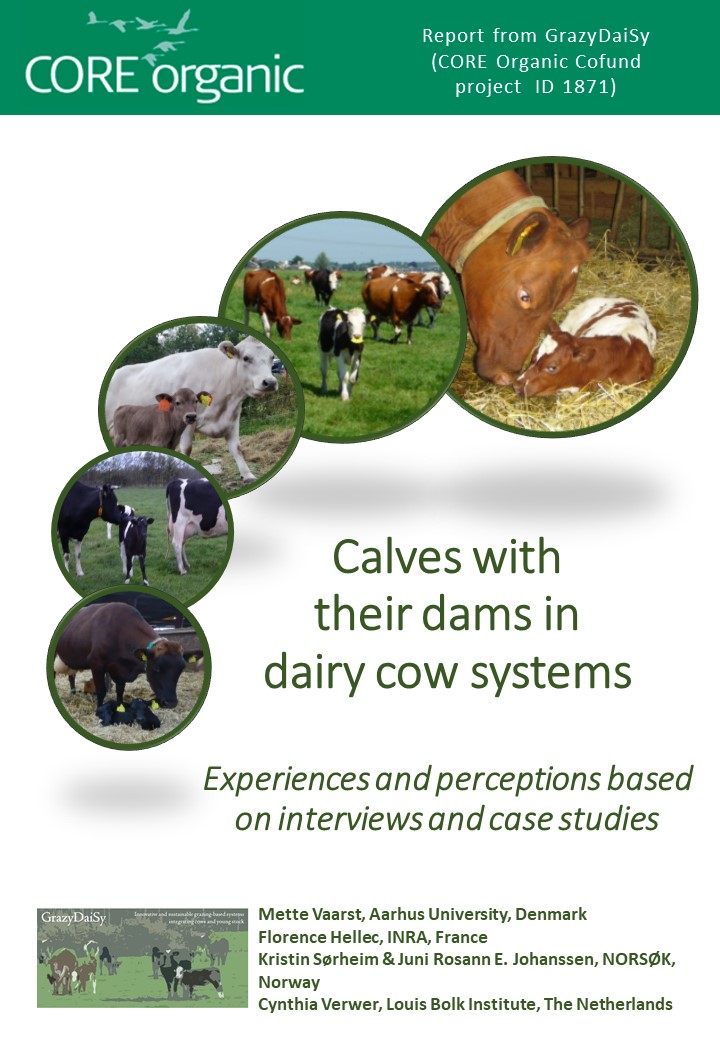How do dairy farmers perceive and experience dam-rearing systems?
Report based on interviews of farmers in France, the Netherlands, Norway and Denmark unfolds different perspectives of cow calf contact systems.

Interviews and on-farm studies in the Netherlands, France, Norway and Denmark showed that dam-rearing is practiced in a wealth of different systems, and farmers considered four main angles to be important in various ways and to various degrees, when they chose and organised a dam-calf contact system, which they found relevant in their farm specific context. These four main angles were calf, cow, farmers and farming system. They perceived that dam-calf contact systems were contributing significantly to the physiology and natural behavior of calves as well as of mother cows. Furthermore, they discussed three important qualities in dam-calf contact systems seen from animals’ perspective: 1) nutrition, 2) care, and 3) learning.
Farmers and other actors described how the aspects of nutrition, care and learning were important features of dam-rearing systems in their views.
The priorities and perceptions of the importance of these three qualities influenced very much the farmers’ choices and priorities of systems. A focus on nutrition could for example motivate the choice of part time systems and strongly restricted systems (e.g. two times two hours daily access to each other), whereas a focus on care and learning would motivate a more full-time access system.
Some farmers perceived the calves to be equipped with capacities and skills through learning from the dam and others in the system, adding to their life opportunities, and they would favor a system where mother cow and calf were together with as little restriction as possible, although such systems require major efforts to organize and keep the overview.
Farmers and advisors, who were introduced to dam-calf contact systems and were confronted with them without having prior experience of these systems, pointed to the need for developing systems, which were much more ‘friendly’ to both cows and calves than what they saw being practices. That is, develop dairy systems, which allowed cows and calves to be together, and the calves to learn about life in a dairy herd (e.g. indoor and outdoor life, and eating solid feed and grass), and with minimum risk. These actors also pointed to the necessity of finding a balance between ‘trusting the animals’ (because they could clearly see that the calves found their way), and ‘being in control’, because they used to know exactly how much milk the calves were drinking on daily basis. This points to the need for the humans in the system to redirect efforts and focus when observing animals, and when spending their time with cows and calves.
Among some interviewed actors, the needs of the calf seemed to be more in focus and of higher priority than the natural needs and the motivation of the mother cow. This is clear when talking about foster cow systems (where the mother cow is separated early after calving from her calf), but also when talking about dam-calf contact systems, many seemed to focus most on the benefits of the calf, although many noticed that the mother cow often reacted strongly to the separation and showed much distress.
Seen from the farmers’ points of view, it was remarkable that most farmers, who had dam-calf contact systems, were mainly driven by the pleasure of seeing it work, and seeing the interaction between calves and cows. They articulated how they were touched and impressed e.g. by the mother cow’s consistent ‘watching over’ her calf, and the pain of separation. A number of the farmers had never been motivated by premium price or consumer demands, but just did it because they found it right, or ‘easier’ in combination that it brought them other qualities being farmers.
There was a repeated questioning of ‘naturalness’ in relation to dam-rearing. Whilst acknowledging that mother cows and calves were strongly motivated and it was ‘natural’ for them to be together, some farmers also pointed to factors which partly made it ‘unnatural’ for them. This was especially the very high milk yields of dairy cows, which could lead to overdrinking for the calf, or deep udders, which made it difficult to drink for the calf, or the fact that daily life in a large dairy herd might not give a newborn calf sufficient peace to rest. The question of naturalness also came up in the discussion of whether it was best that the calf can find its mother, or the mother find her calf, or how they both have more or less unrestricted access to each other, but then with no opportunity to seek peace in a calf hide.
Some issues remained unsolved at the current moment, and they need future solutions. One is the difference in many herds between ‘calves to stay in the herd’ versus ‘calves to leave the herds’ and not least their mothers, which had to go through early and abrupt separation.
